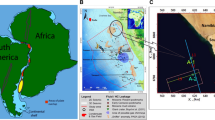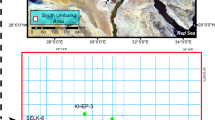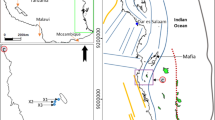Abstract
Identifying stratigraphic traps in highly faulted rift basins such as the Rawat Basin in southeastern Sudan is challenging as a result of the intensive tectonic events. Sedimentological studies in the basin indicate the possibility of enormous petroleum potential locked up within several stratigraphic traps. This study examined the petroleum prospects in the basin beyond the conventional structural trapped systems that have yielded limited hydrocarbon prospectivity. This article utilizes core feature analysis to identify the primary sedimentary environments, employs seismic stratigraphy to determine sedimentary cycles, and conducts seismic facies analysis. Sequence stratigraphic and seismic facies analyses, core data, and log signatures from eight exploratory wells were analysed and employed to define the dynamic depositional processes of the fluvial and lacustrine sandstones and mudstones of the lower to upper Cretaceous first rift cycle in the Rawat central sub-basin. The core analysis indicates fluvial to deltaic depositional environment, while the log signatures, which showed bell, funnel, and serrated shapes, correspond to braided delta and lacustrine environments in the Galhak sand, Galhak, and Mulet Formations, respectively. The motifs and lithology were interpreted as indicating variations in lithology. The sediments were composed of low-energy particle sizes and were highly well sorted with a laminated bed of silt clay, and the variation in clay color indicates the deposition in a weak reduction–oxidation environment with shallow water; all these indicate the fluvial lacustrine setting. The concept of seismic stratigraphy applied identified a first-order cycle that includes low-stand system tract, transgressive systems tract, and high-stand systems tract. The first-order cycle is subdivided into two major second-order cycles, which are further divided into five para-sequence sets. The sets from the bottom to the top include SQ1, SQ2, SQ3, SQ4, and SQ5. Seismic facies analysis identified wedge chaotic progradational configuration, parallel seismic facies, sub-parallel, hummocky, and discontinuous reflectors within the first-order cycle, which confirmed the setting to be fluvial lacustrine. The stratigraphic traps recognised in the central sub-basin are lateral facies change as one of the depositional traps and the truncation in the northeast of the central sub-basin. The combined strengths of seismic stratigraphy and seismic facies analysis with the litho-facies association have greatly enhanced the identification of stratigraphic traps, some of which could have significant hydrocarbon prospects.























Similar content being viewed by others
References
Ahmed HA, Ozumba MB (2017) Geology of the Muglad Rift Basin of interior Sudan. IOSR J Appl Geol Geophys 5(5):19–25. https://doi.org/10.9790/0837-0505011925
BeicipFranlab (2009) High-resolution sequence stratigraphy in 3D area, Mulet basin, Sudan, final report, PDOC, Sudan
Berg OR (1982) Seismic detection and evaluation of delta and turbidities sequences: their application to the exploration for the subtle trap. Am Assoc Pet Geol Bull 66(9):57–75
Brown LF, Fisher WL (1980) Seismic stratigraphy interpretation and petroleum exploration. American Association of Petroleum Geologists
Catuneanu O (2019) Model-independent sequence stratigraphy. Earth Sci Rev 188:312–388
Catuneanu O, Abreu V, Bhattacharya JP, Blum MD, Dalrymple RW, Eriksson PG, Fielding CR, Fisher WL, Galloway WE, Gibling MR (2009) Towards the standardization of sequence stratigraphy. Earth Sci Rev 92(1–2):1–33
Daly MC, Chorowicz J, Fairhead JD (1989) Rift basin evolution in Africa: the influence of reactivated steep basement shear zones. Geol Soc Lond Spec Publ 44(1):309–334
Dolson JC, Bahorich MS, Tobin RC, Beaumont EA, Terlikoski LJ, Hendricks ML (2019) Exploring Stratigraphic Traps.
Dou L, Xiao K, Cheng D, Shi B, Li Z (2007) Petroleum geology of the Melut Basin and the Great Palogue Field, Sudan. Mar Pet Geol 24(3):129–144. https://doi.org/10.1016/j.marpetgeo.2006.11.001
El-Tayeb A, Mahmud O A (2006) Tectonics, seismic and sequence stratigraphy of Melut Rift Basin, Sudan. PGCE 2006, cp-256
Embry AF (2009) Practical sequence stratigraphy. Canadian Society of Petroleum Geologists, pp. 81, 79
Fairhead JD, Binks RM (1991) Differential opening of the Central and South Atlantic Oceans and the opening of the West African rift system. Tectonophysics 187(1–3):191–203
Fairhead JD, Green CM, Masterton SM, Guiraud R (2013) The role that plate tectonics, inferred stress changes, and stratigraphic unconformities have on the evolution of the West and Central African Rift System and the Atlantic continental margins. Tectonophysics 594:118–127. https://doi.org/10.1016/j.tecto.2013.03.021
Genik GJ (1993) Petroleum geology of cretaceous-tertiary rift basins in Niger, Chad, and the Central African Republic. AAPG Bull 77(8):1405–1434
Guiraud R, Maurin JC (1992) Early Cretaceous rifts of Western and Central Africa: an overview. Tectonophysics 213(1–2):153–168. https://doi.org/10.1016/0040-1951(92)90256-6
Haq BU, Hardenbol JAN, Vail PR (1987) Chronology of fluctuating sea levels since the Triassic. Science 235(4793):1156–1167
Li Z, Wan L, Liu J, Pan X, Xue L, Su Y (2014) Geodynamic characteristics and their effect on the petroleum geology conditions for Passive Rift Basin in central-western African region*
Mchargue TR, Heidrick TL, Livingston JE (1992) Tectonostratigraphic development of the interior Sudan rifts, Central Africa. Tectonophysics 213(1–2):187–202
Mitchum Jr RM, Vail PR, Thompson III S (1977) Seismic stratigraphy and global changes of sea level: part 2. The depositional sequence as a basic unit for stratigraphic analysis: section 2. Application of seismic reflection configuration to stratigraphic interpretation
Rider MH (1999) Geologic interpretation of wells logs Whittles Publishing Services Geological application of wireline logs. In: Hurst A, AL M, CM A (Eds.), 48, 27–37
Roksandić MM (1978) Seismic facies analysis concepts. Geophys Prospect 26(2):383–398
Salama RB (1987) The evolution of the river Nile. The buried saline rift lakes in Sudan—I. Bahr El Arab Rift, the Sudd buried saline lake. J Afr Earth Sci (1983) 6(6):899–913
Sangree JB, Widmier JM (1977) Seismic stratigraphy and global changes of sea level: part 9. Seismic interpretation of clastic depositional facies: section 2. Application of seismic reflection configuration to stratigraphic interpretation
Schull TJ (1988) Rift basins of interior Sudan: petroleum exploration and discovery. AAPG (Am. Assoc. Pet. Geol.) Bull.; (United States) 72:10
Vail PR, Mitchum Jr RM, Thompson III S (1977) Seismic stratigraphy and global changes of sea level: part 3. Relative changes of sea level from Coastal Onlap: section 2. Application of seismic reflection Configuration to Stratigraphic Interpretation
Van Wagoner JC, Mitchum RM, Campion KM, Rahmanian VD (1990) Siliciclastic sequence stratigraphy in well logs, cores, and outcrops: concepts for high-resolution correlation of time and facies
Xu G, Haq BU (2022) Seismic facies analysis: past, present, and future. In Earth-Science Reviews (Vol. 224). Elsevier B.V. https://doi.org/10.1016/j.earscirev.2021.103876
Z M, MZ A, A2 E (2017) Upper Cretaceous to Neogene palynology of the Rawat Basin, White Nile State, Sudan. J Earth Sci Clim Change 08(04). https://doi.org/10.4172/2157-7617.1000397
Author information
Authors and Affiliations
Corresponding author
Ethics declarations
Conflict of interest
The authors declare no competing interests.
Additional information
Responsible Editor: Abdullah M. Al-Amri
Rights and permissions
Springer Nature or its licensor (e.g. a society or other partner) holds exclusive rights to this article under a publishing agreement with the author(s) or other rightsholder(s); author self-archiving of the accepted manuscript version of this article is solely governed by the terms of such publishing agreement and applicable law.
About this article
Cite this article
Hassan, A.H.O., Osinowo, O.O. & Zayed, M.A. Application of seismic sequence stratigraphy and seismic facies analyses for identifying stratigraphic trap system within Rawat central sub-basin, White Nile State, Sudan. Arab J Geosci 17, 25 (2024). https://doi.org/10.1007/s12517-023-11826-y
Received:
Accepted:
Published:
DOI: https://doi.org/10.1007/s12517-023-11826-y




